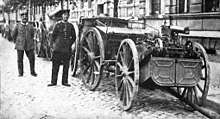Tachanka
A tachanka (Russian: тача́нка, Ukrainian: тачанка, Polish: taczanka) was a horse-drawn machine gun, usually a cart (such as charabanc) or an open wagon with a heavy machine gun installed in the back. A tachanka could be pulled by two to four horses and required a crew of two or three (one driver and a machine gun crew). A number of sources attribute its invention to Nestor Makhno.[1][2][3][4][5]

Etymology

There are at least two plausible hypotheses regarding the origin of the word tachanka. The etymological dictionary of Vasmer suggests that the word derives from Ukrainian netychanka ("нетичанка"), Polish najtyczanka, a type of a carriage named after the town of Neutitschein, now Nový Jičín in the Czech Republic.[6] According to another opinion, it is a Ukrainian diminutive, or endearing form of the word tachka (Ukrainian: та́чка, meaning 'wheelbarrow'). Still another opinion is that it is a contracted word 'tavrichanka' for rugged carriages known in Southern Ukraine and Crimea, derived from the name "Taurida" for this area. However the latter derivation is dubious because the 'tavrichanka', a large, rugged agricultural carriage, is of completely different design.
Adoption
A regular civilian horse cart could be easily converted to military use and back. This made the tachanka very popular during the Great War on the Eastern Front, where it was used by the Russian cavalry. The use of tachankas reached its peak during the Russian Civil War (1917–1920s), particularly in the peasant regions of Southern Russia and Ukraine, where the fronts were fluid and mobile warfare gained much significance. With up to 4 horses abreast pulling a tachanka, it could easily keep up with cavalry units and support them with mobile firepower.
Tachanka tactics were centered around taking advantage of its speed to surprise the enemy. Tachankas, before the introduction of the tank or automobile to the battlefield, were the only way to provide high-speed mobility for the heavy, bulky machine guns of World War I. The speed of the horse-drawn cart would be used to move the machine gun platform to a favorable firing position, and then the enemy would be fired upon before they had a chance to react. Since the machine gun pointed towards the rear of the cart, the tachankas also provided effective suppressive fire onto pursuing enemy cavalry after raids and during retreats. Ukrainian anarchist leader Nestor Makhno pioneered the use of the tachanka en masse during the Russian Civil War. Makhno's forces relied so heavily upon the use of the tachanka that one Makhnovite referred to himself and his fellow troops as "a republic on tachanki".[7] The Revolutionary Insurrectionary Army of Ukraine used tachankas mainly against enemy cavalry. Makhnovists also used tachankas to transport infantry, thus improving mobility of the army (about 100 km each day). Tachankas soon became used by the Red Army, with the famous example of Vasily Chapayev.
Later, it was adopted by a number of armies, notably the Polish Army which used it during the Polish-Soviet War. Initially mostly improvised, with time the Polish Army also adopted two models of factory-made taczankas, as they were called in Poland. They were used during the Invasion of Poland of 1939 to provide cavalry squadron support. They were attached to every cavalry HMG squadron and HMG company of infantry.
Armament
Despite a certain degree of standardisation, the tachanka's armament was, in most cases, improvised. In Russia, the PM M1910 heavy machine gun was often used. The Polish cavalry of the Polish-Soviet War often used all kinds of machine guns available, including the Maxim, Schwarzlose MG M.07/12, Hotchkiss machine gun and Browning machine gun. The late models of standardised tachankas of the Polish Army were all equipped with Ckm wz.30, a Polish modification of the M1917 Browning machine gun which was also suitable for anti-air fire.
Cultural references
One of the songs glorifying the Red Army during the Russian Civil War was called "Tachanka". The concluding lyrics, roughly translated, run:[8]
- And to this day, the foe has nightmares
- Of the thick rain of lead,
- The battle-chariot
- And the young machine gunner.
Tachankas can be seen in the classic Soviet films Chapayev and The Burning Miles. A modern variant of tachanka can be seen in a cult Russian film Brother 2.
In the video game Tom Clancy's Rainbow Six Siege, there is a playable Russian operator by the name of Alexsandr "Tachanka" Senaviev, who has the ability to deploy a Degtyaryov machine gun on a shielded tripod.[9]
References
- Chamberlin, William Henry (1970). Russia's Iron Age. Ayer Publishing. p. 201. ISBN 0-405-03013-4.
- Rapoport, V.; Alekseev, Y.; Treml, V. G. (1985). High Treason: Essays on the History of the Red Army, 1918–1938. Translated by Adams, B. Duke University Press. p. 68. ISBN 0-8223-0647-6.
- Malet, Michael (1982). Nestor Makhno in the Russian Civil War. Macmillan. p. 85. ISBN 0-333-25969-6.
- Zaloga, Steve; Ness, Leland S. (1998). Red Army Handbook, 1939–45. Sutton. p. 105. ISBN 0-7509-1740-7.
- Trotsky, Leon (1981). How the Revolution Armed: The Military Writings and Speeches of Leon Trotsky. New Park Publications. p. 295.
- Vasmer's dictionary entry
- Charles Townshend, The Oxford History of Modern War, Oxford University Press, 2005, p186
- http://www.sovmusic.ru/english/text.php?fname=tachanka
- https://rainbow6.ubisoft.com/siege/en-us/game-info/operators/tachanka/index.aspx
External links
| Wikimedia Commons has media related to Tachanka. |